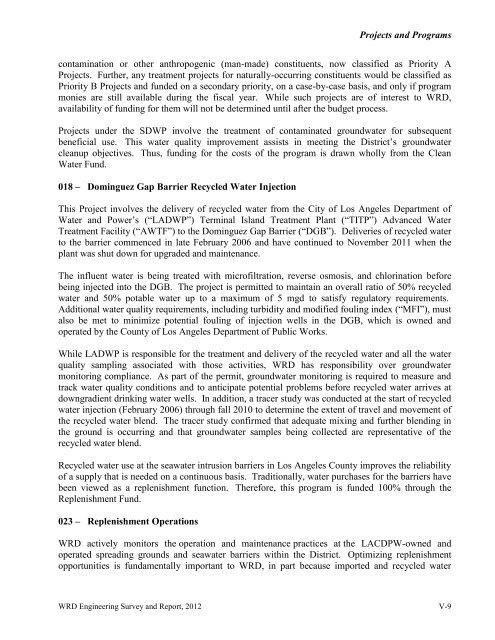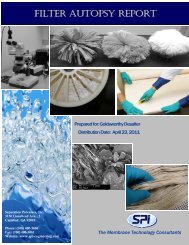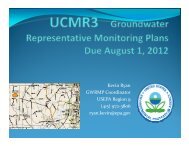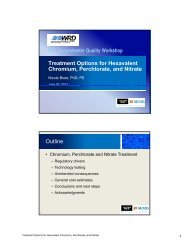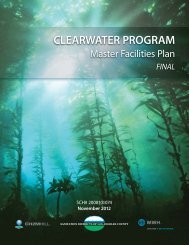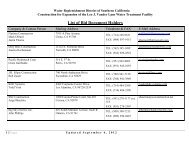Download pdf - Water Replenishment District of Southern California
Download pdf - Water Replenishment District of Southern California
Download pdf - Water Replenishment District of Southern California
You also want an ePaper? Increase the reach of your titles
YUMPU automatically turns print PDFs into web optimized ePapers that Google loves.
Projects and Programs<br />
contamination or other anthropogenic (man-made) constituents, now classified as Priority A<br />
Projects. Further, any treatment projects for naturally-occurring constituents would be classified as<br />
Priority B Projects and funded on a secondary priority, on a case-by-case basis, and only if program<br />
monies are still available during the fiscal year. While such projects are <strong>of</strong> interest to WRD,<br />
availability <strong>of</strong> funding for them will not be determined until after the budget process.<br />
Projects under the SDWP involve the treatment <strong>of</strong> contaminated groundwater for subsequent<br />
beneficial use. This water quality improvement assists in meeting the <strong>District</strong>’s groundwater<br />
cleanup objectives. Thus, funding for the costs <strong>of</strong> the program is drawn wholly from the Clean<br />
<strong>Water</strong> Fund.<br />
018 – Dominguez Gap Barrier Recycled <strong>Water</strong> Injection<br />
This Project involves the delivery <strong>of</strong> recycled water from the City <strong>of</strong> Los Angeles Department <strong>of</strong><br />
<strong>Water</strong> and Power’s (“LADWP”) Terminal Island Treatment Plant (“TITP”) Advanced <strong>Water</strong><br />
Treatment Facility (“AWTF”) to the Dominguez Gap Barrier (“DGB”). Deliveries <strong>of</strong> recycled water<br />
to the barrier commenced in late February 2006 and have continued to November 2011 when the<br />
plant was shut down for upgraded and maintenance.<br />
The influent water is being treated with micr<strong>of</strong>iltration, reverse osmosis, and chlorination before<br />
being injected into the DGB. The project is permitted to maintain an overall ratio <strong>of</strong> 50% recycled<br />
water and 50% potable water up to a maximum <strong>of</strong> 5 mgd to satisfy regulatory requirements.<br />
Additional water quality requirements, including turbidity and modified fouling index (“MFI”), must<br />
also be met to minimize potential fouling <strong>of</strong> injection wells in the DGB, which is owned and<br />
operated by the County <strong>of</strong> Los Angeles Department <strong>of</strong> Public Works.<br />
While LADWP is responsible for the treatment and delivery <strong>of</strong> the recycled water and all the water<br />
quality sampling associated with those activities, WRD has responsibility over groundwater<br />
monitoring compliance. As part <strong>of</strong> the permit, groundwater monitoring is required to measure and<br />
track water quality conditions and to anticipate potential problems before recycled water arrives at<br />
downgradient drinking water wells. In addition, a tracer study was conducted at the start <strong>of</strong> recycled<br />
water injection (February 2006) through fall 2010 to determine the extent <strong>of</strong> travel and movement <strong>of</strong><br />
the recycled water blend. The tracer study confirmed that adequate mixing and further blending in<br />
the ground is occurring and that groundwater samples being collected are representative <strong>of</strong> the<br />
recycled water blend.<br />
Recycled water use at the seawater intrusion barriers in Los Angeles County improves the reliability<br />
<strong>of</strong> a supply that is needed on a continuous basis. Traditionally, water purchases for the barriers have<br />
been viewed as a replenishment function. Therefore, this program is funded 100% through the<br />
<strong>Replenishment</strong> Fund.<br />
023 – <strong>Replenishment</strong> Operations<br />
WRD actively monitors the operation and maintenance practices at the LACDPW-owned and<br />
operated spreading grounds and seawater barriers within the <strong>District</strong>. Optimizing replenishment<br />
opportunities is fundamentally important to WRD, in part because imported and recycled water<br />
WRD Engineering Survey and Report, 2012 V-9


